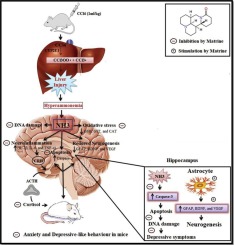当前位置:
X-MOL 学术
›
Neurotoxicology
›
论文详情
Our official English website, www.x-mol.net, welcomes your
feedback! (Note: you will need to create a separate account there.)
Matrine ameliorates anxiety and depression-like behaviour by targeting hyperammonemia-induced neuroinflammation and oxidative stress in CCl4 model of liver injury.
NeuroToxicology ( IF 3.4 ) Pub Date : 2019-02-08 , DOI: 10.1016/j.neuro.2019.02.002 Adnan Khan 1 , Bushra Shal 1 , Muhammad Naveed 1 , Fawad Ali Shah 2 , Ayesha Atiq 1 , Naseem Ullah Khan 1 , Yeong Shik Kim 3 , Salman Khan 1
NeuroToxicology ( IF 3.4 ) Pub Date : 2019-02-08 , DOI: 10.1016/j.neuro.2019.02.002 Adnan Khan 1 , Bushra Shal 1 , Muhammad Naveed 1 , Fawad Ali Shah 2 , Ayesha Atiq 1 , Naseem Ullah Khan 1 , Yeong Shik Kim 3 , Salman Khan 1
Affiliation

|
Acute or chronic liver injury is associated with hyperammonemia which induced neuroinflammation and oxidative stress in the brain. Neuroinflammation, oxidative stress, reduced neurogenesis, and apoptosis are critical factors for the development of anxiety and depression. The present study was aimed to evaluate the anxiolytic and antidepressant properties of matrine against acute liver injury in the rodent model. Acute liver injury in mice was induced by administration of the acute hepatotoxic dose of carbon tetrachloride (CCl4) (1 ml/kg, i.p.). Pretreatment of mice with matrine (50 mg/kg i.p.) remarkably ameliorated CCl4-induced anxiety and depression-like behavior as evident from the results of open field test (OFT), elevated plus maze test (EPM), light-dark box test (LDB), forced swimming test (FST), and tail suspension test (TST). Moreover, matrine significantly inhibited CCl4-induced neuroinflammation in mice by reducing pro-inflammatory cytokines such as interleukins (IL-1β, IL-6) and tumor necrosis factor-α (TNF-α) levels in the hippocampus (HC) and prefrontal cortex (PFC). CCl4-induced oxidative stress was reduced by matrine due to its potential to enhance the levels of reduced glutathione (GSH), catalase (CAT), glutathione-S-transferase (GST), and decreased the malondialdehyde (MDA), and nitrite level in the PFC and HC of mice brain. Matrine remarkably reduced the levels of corticosterone, ammonia, AST, ALT, and creatinine. Matrine pretreatment remarkably ameliorated CCl4-induced morphological liver injury. Acute pretreatment of matrine enhanced neurogenesis by increasing the number of GFAF (glial fibrillary acidic protein) positive astrocyte, BDNF (brain-derived neurotrophic factor), and VEGF (vascular endothelial growth factor) in the hippocampus of CCl4-treated mice. Pretreatment of matrine inhibited apoptosis and DNA damage in the hippocampus. The present data revealed that hyperammonemia produced due to liver injury induced oxidative stress, neuroinflammation, reduced neurogenesis and apoptosis in the hippocampus, thus, resulting in anxiety and depression. Taken together, the present results suggested that matrine has a significant antidepressant and anxiolytic effects through modulation of neuroinflammation, oxidative stress, reduced neurogenesis and apoptosis induced by CCl4 administration.
中文翻译:

苦参碱通过针对肝损伤的CCl4模型中的高氨血症诱导的神经炎症和氧化应激,改善焦虑和抑郁样行为。
急性或慢性肝损伤与高氨血症有关,高氨血症会引起脑部神经炎症和氧化应激。神经炎症,氧化应激,减少的神经发生和细胞凋亡是焦虑和抑郁症发展的关键因素。本研究旨在评估苦参碱对啮齿动物模型急性肝损伤的抗焦虑和抗抑郁作用。通过给予急性肝毒性剂量的四氯化碳(CCl4)(1 ml / kg,ip)诱发小鼠急性肝损伤。从野外试验(OFT),高架迷宫试验(EPM),明暗盒试验的结果可以明显看出,用苦参碱(50 mg / kg ip)预处理小鼠可显着改善CCl4诱导的焦虑和抑郁样行为。 LDB),强迫游泳测试(FST)和尾部悬挂测试(TST)。而且,苦参碱可通过减少海马(HC)和前额叶皮层(PFC)中的促炎细胞因子(例如白介素(IL-1β,IL-6)和肿瘤坏死因子-α(TNF-α)含量)来显着抑制CCl4诱导的小鼠神经炎症。 )。苦参碱可降低CCl4诱导的氧化应激,因为它具有增强还原型谷胱甘肽(GSH),过氧化氢酶(CAT),谷胱甘肽S-转移酶(GST)的水平,并降低丙二醛(MDA)和亚硝酸盐水平的潜力。小鼠大脑的PFC和HC。苦参碱显着降低了皮质酮,氨,AST,ALT和肌酐的水平。苦参碱预处理显着改善了CCl4诱导的形态学肝损伤。苦参碱的急性预处理通过增加GFAF(胶质纤维酸性蛋白)阳性星形胶质细胞的数量来增强神经发生,CCl4处理的小鼠海马中的BDNF(脑源性神经营养因子)和VEGF(血管内皮生长因子)。苦参碱预处理可抑制海马细胞凋亡和DNA损伤。目前的数据表明,由于肝损伤而产生的高氨血症引起海马氧化应激,神经炎症,神经生成减少和细胞凋亡,从而导致焦虑和抑郁。综上所述,本发明结果表明苦参碱具有通过调节神经炎症,氧化应激,减少神经发生和由CCl4给药诱导的细胞凋亡而具有显着的抗抑郁和抗焦虑作用。目前的数据表明,由于肝损伤而产生的高氨血症引起海马氧化应激,神经炎症,神经发生减少和海马细胞凋亡,从而导致焦虑和抑郁。综上所述,本发明结果表明苦参碱具有通过调节神经炎症,氧化应激,减少的神经发生和由CCl4给药诱导的细胞凋亡而具有显着的抗抑郁和抗焦虑作用。目前的数据表明,由于肝损伤而产生的高氨血症引起海马氧化应激,神经炎症,神经发生减少和海马细胞凋亡,从而导致焦虑和抑郁。综上所述,本发明结果表明苦参碱具有通过调节神经炎症,氧化应激,减少神经发生和由CCl4给药诱导的细胞凋亡而具有显着的抗抑郁和抗焦虑作用。
更新日期:2019-02-08
中文翻译:

苦参碱通过针对肝损伤的CCl4模型中的高氨血症诱导的神经炎症和氧化应激,改善焦虑和抑郁样行为。
急性或慢性肝损伤与高氨血症有关,高氨血症会引起脑部神经炎症和氧化应激。神经炎症,氧化应激,减少的神经发生和细胞凋亡是焦虑和抑郁症发展的关键因素。本研究旨在评估苦参碱对啮齿动物模型急性肝损伤的抗焦虑和抗抑郁作用。通过给予急性肝毒性剂量的四氯化碳(CCl4)(1 ml / kg,ip)诱发小鼠急性肝损伤。从野外试验(OFT),高架迷宫试验(EPM),明暗盒试验的结果可以明显看出,用苦参碱(50 mg / kg ip)预处理小鼠可显着改善CCl4诱导的焦虑和抑郁样行为。 LDB),强迫游泳测试(FST)和尾部悬挂测试(TST)。而且,苦参碱可通过减少海马(HC)和前额叶皮层(PFC)中的促炎细胞因子(例如白介素(IL-1β,IL-6)和肿瘤坏死因子-α(TNF-α)含量)来显着抑制CCl4诱导的小鼠神经炎症。 )。苦参碱可降低CCl4诱导的氧化应激,因为它具有增强还原型谷胱甘肽(GSH),过氧化氢酶(CAT),谷胱甘肽S-转移酶(GST)的水平,并降低丙二醛(MDA)和亚硝酸盐水平的潜力。小鼠大脑的PFC和HC。苦参碱显着降低了皮质酮,氨,AST,ALT和肌酐的水平。苦参碱预处理显着改善了CCl4诱导的形态学肝损伤。苦参碱的急性预处理通过增加GFAF(胶质纤维酸性蛋白)阳性星形胶质细胞的数量来增强神经发生,CCl4处理的小鼠海马中的BDNF(脑源性神经营养因子)和VEGF(血管内皮生长因子)。苦参碱预处理可抑制海马细胞凋亡和DNA损伤。目前的数据表明,由于肝损伤而产生的高氨血症引起海马氧化应激,神经炎症,神经生成减少和细胞凋亡,从而导致焦虑和抑郁。综上所述,本发明结果表明苦参碱具有通过调节神经炎症,氧化应激,减少神经发生和由CCl4给药诱导的细胞凋亡而具有显着的抗抑郁和抗焦虑作用。目前的数据表明,由于肝损伤而产生的高氨血症引起海马氧化应激,神经炎症,神经发生减少和海马细胞凋亡,从而导致焦虑和抑郁。综上所述,本发明结果表明苦参碱具有通过调节神经炎症,氧化应激,减少的神经发生和由CCl4给药诱导的细胞凋亡而具有显着的抗抑郁和抗焦虑作用。目前的数据表明,由于肝损伤而产生的高氨血症引起海马氧化应激,神经炎症,神经发生减少和海马细胞凋亡,从而导致焦虑和抑郁。综上所述,本发明结果表明苦参碱具有通过调节神经炎症,氧化应激,减少神经发生和由CCl4给药诱导的细胞凋亡而具有显着的抗抑郁和抗焦虑作用。











































 京公网安备 11010802027423号
京公网安备 11010802027423号